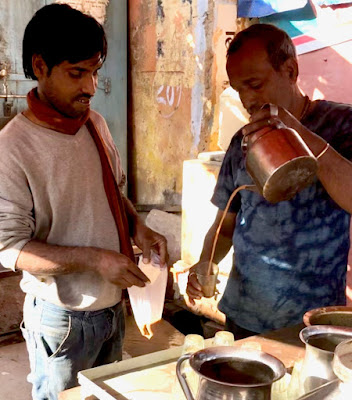4. Exploring Bijaipur village
Bijaipur
The castle is the focal part of the village. We had enough time to really explore - either wandering around on our own or on guided walking, riding or cycling trips with K.P
The castle is the focal part of the village. We had enough time to really explore - either wandering around on our own or on guided walking, riding or cycling trips with K.P
The village of Bijaipur reclines at the foot of the Vindhyanchal hills. There are just over 300 houses and a population of approximately 2,200 people. The surrounding agricultural lands harvests peanuts, mustard, corn and poppies. This is an agricultural economy.
Sunrise over the village
In the centre of town is the market selling lots of fresh fruit and vegetables, including long thin red carrots, small aubergines, all sorts of beans, bananas, cabbage, sweet potatoes, tomatoes, herbs, garlic, ginger and fresh turmeric.
Fresh Tumeric
There was a Chaiwala in the market square selling masala chai - a tea whose recipe varies everywhere you go but made up with about half milk to water, tea and then any combination of ginger, cardamon, cinnamon, cloves and star anise. In India, in order to cut down on the use of plastics, in only one year they have managed to ban the use of all polythene bags. An exception to this rule is the chaiwala who is allowed to use a bag to deliver his tea - each one has the number of cups measured out ready to take away!
Just down the road is the man who does the village ironing in just a lean to shack outside. His iron is filled with hot coals and weighs 8kg. He dropped it once and part of it broke - you can see the mend!
One day walking in the village we passed lots of people all sitting down in rows enjoying a meal. It turned out that someone from the village had died recently so food was provided for everyone.
As well as the main villagers there are other people living in the area including the nomadic Kanjar tribe. Allegedly descendants of Ghengis Khan, a 12th Century founder of the Mongol empire. Branded as criminals and notorious for unlawful activities like theft and brewing illicit liquor, they have often faced ostracism. Despite this they have adhered to their customs and continue to honour their dead in a unique way. The dead are cremated but instead of immersing the remains the ashes are buried under a tomb - a practice similar to the Egyptians. Each tomb also has a small hole on top, acting as a door for the souls to go on earthly visits. Knick-knacks including jewellery, mirrors, combs, clothes, hair oil, soap, a few rupees, tobacco and a few bidis. Every Hole, Diwali, Rakhi and Amavasya, the tribe gather at the crematorium ground and while sharing prayers enjoy a favourite homemade bottle of the departed one ... sharing some of it with them by pouring it into the tomb through a small hole at the front.
The tomb stone depicts something of their life in pictorial form.
Another group are the Bhil people, the largest tribal group in India, speaking their own Bhili language. The word "Bhil" means "bow" and reflects their history as skilled archers. They are also skilled wall painters and have a rich and unique culture with nature at its centre. However they have been exploited for centuries both by the British Raj and the government of modern India. Traditionally they aimed for self subsidence and protecting the environment and lacked any commercial interests. For example they implemented a limit on storing production surpluses, beyond which all surpluses would be used to hold feasts in the community, rather than accumulating them or engaging in trade.
The British extracted timber from their lands and displaced them, making it difficult for them to follow their traditional practices of subsistence. Their condition further worsened after Independence in 1947 when Indian rulers intensified the process of extraction and failed to provide the tribals with the necessary tools to survive in the modern world such as medicine, education or economic skills. Then in 2017 the government inaugurated the Sarover Dam - the second largest dam in the world, displacing thousands of people to areas far less fertile higher on the hillsides. Many on them are forced to migrate to cities to find unskilled labour earning meagre incomes or survive on subsistence farming. The Bhils that we visited are now receiving free education for their children and receive a modest grant from the government to help them survive but they live in very basic conditions with very little.
The British extracted timber from their lands and displaced them, making it difficult for them to follow their traditional practices of subsistence. Their condition further worsened after Independence in 1947 when Indian rulers intensified the process of extraction and failed to provide the tribals with the necessary tools to survive in the modern world such as medicine, education or economic skills. Then in 2017 the government inaugurated the Sarover Dam - the second largest dam in the world, displacing thousands of people to areas far less fertile higher on the hillsides. Many on them are forced to migrate to cities to find unskilled labour earning meagre incomes or survive on subsistence farming. The Bhils that we visited are now receiving free education for their children and receive a modest grant from the government to help them survive but they live in very basic conditions with very little.



























Comments
Post a Comment